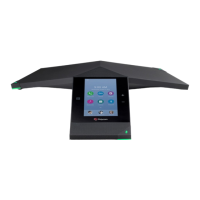Administrator’s Guide for Polycom HDX Systems
8–22 Polycom, Inc.
• Remote IP address (that is, the addresses of people logged in to the system
from their computers)
To view the Sessions List:
>> From the local interface, go to System > Diagnostics > Sessions.
>> From the web interface, go to Diagnostics > Sessions.
Managing Certificates and Revocation
If your organization has deployed a public key infrastructure (PKI) for
securing connections between devices on your network, Polycom
recommends that you have a strong understanding of certificate management
and how it applies to Polycom HDX systems before you integrate these
products with the PKI.
Polycom HDX systems can use certificates to authenticate network
connections to and from the HDX system. Other web applications also use
certificates, as you might notice when you navigate the Internet. The system
uses configuration and management techniques typical of PKI to manage
certificates, certificate signing requests, and revocation checking. ANSI X.509
standards regulate the characteristics of certificates and revocation.
Polycom HDX systems are able to generate requests for certificates (CSRs) that
can be then sent to a certificate authority (CA) for official issuance. The CA is
the trusted entity that issues, or signs, digital certificates for others. Once
signed by the CA, the certificate can then be installed on the HDX system for
use in all TLS connections used by the system.
HDX systems support and typically require the generation and use of two
separate certificates when used in an environment that has a fully deployed
PKI:
1 A Server certificate—the HDX system’s web server presents this
certificate after receiving connection requests from browsers attempting
to connect to the Polycom HDX web interface.
2 A Client certificate—the HDX system presents this certificate to a remote
server when challenged to provide a certificate as part of authenticating
the identity of the HDX system before allowing it to connect to the remote
server. Examples of remote servers include the RealPresence
®
Resource
Manager system, a SIP proxy/registrar server, or an LDAP directory
server.
When Polycom HDX systems are deployed in an environment that does not
have a fully deployed PKI, you do not need to install these certificates because
all HDX systems automatically generate self-signed certificates that can be used
to establish secure TLS connections. However, when a full PKI has been
Artisan Technology Group - Quality Instrumentation ... Guaranteed | (888) 88-SOURCE | www.artisantg.com

